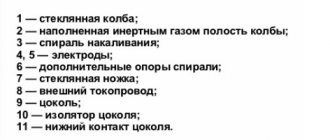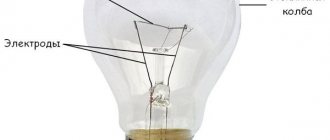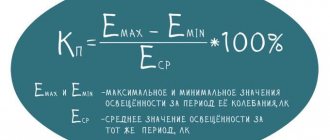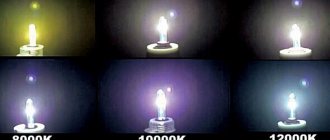What it is
By socket we mean, in a sense, an adapter between the socket and the lighting fixture. It ensures reliable fixation of the flask with its contents in a specific connector that is connected to the power source.
Externally, the case may look like a sealed box in which the contacts are completely hidden. An example is Edison's invention. Most variations are represented by a block from which metal pins, plates, and wires are released, which are responsible for conducting energy from the cartridge to the diodes or filaments.
Inside the simplest base
Threaded base E
This species is found in the following variations: E5, E10, E12, E14, E17, E26, E27, E40. The presented types of bases are characterized by sizes from minimum to maximum. For example, version E5 is characterized by a height and diameter of 5 mm.
The threaded holder can be installed in halogen, fluorescent and incandescent analogues. In addition, LED light sources are quite often found with just such a base.
The most common: E14, E27, E40. Moreover, the latter type is often installed in fluorescent mercury lighting sources, and is also part of incandescent lamps. E14 is usually built into mushroom-shaped light sources and candle-shaped analogues, “candles in the wind”. E27 can be found as a lamp holder for absolutely any type of lamp.
Another feature of the E14, E27, E40 sockets is power supply from a 220 volt network. Thanks to this, energy-saving lamps that require the use of ballasts can be connected directly to the power source.
Characteristics
The dimensions of the bases are not always directly proportional to the required output luminous flux power. For example, E40 has a coil diameter of 40 mm, and R7 only 7 mm. And the output power of the former reaches 1000 W, while the latter can shine at 1500 W.
The markings of the bases of all light bulbs are presented in uppercase, lowercase letters and numbers. By number we mean geometric characteristics. The Latin alphabet means the following:
| B | Pin (bayonet) | s | 1 contact |
| E | Threaded (Edison) | d | 2 contacts |
| G | Pin | t | 3 contacts |
| K | Cable | q | 4 contacts |
| P | Focusing | p | 5 contacts |
| R | With recessed contacts | ||
| S | Soffitny | ||
| T | Telephone | ||
| W | Baseless lamps |
Marking
If the number appears immediately after the capital letter, then it indicates the outer diameter of the base (E27) or the distance between the central points of the protruding contact elements (G4).
Additionally, A (car lamp), U (energy saving) or V (conical shape of the lower part of the base) may be indicated.
Regulatory types of LED lamp bases
LED lamps are available with both threaded and contact sockets.
LED lamp screw sockets
This list contains four lamp labels based on base type.
- E14 – LED minion lamp;
- E24 LED lamp for a standard socket.
- Less known paws: E10 (refrigerator) and E42 (for streets).
LED lamp sockets
Pin sockets
- G13. LED lamps with T8 and T10 tubes.
- GU10. LED bulbs. Pins with thickening at the ends.
- GU5.3. LED and halogen lamps.
- G53. Halogen lamps
- G4, GU4 and G9 LED lamps for design lighting.
- B22 - pin base diameter 22 mm
We understand that the numbers after the letter are the distance between the pins.
Related articles: Apartment lighting groups
Types of bases and their markings
Whatever the choice of bases, among the variety, today the leading position is held by a conventional light bulb with a tungsten filament. It has a screw base with a diameter of 27 mm. Marked as E27. They are not replacing, but pin, baseless and linear analogues with recessed contacts are gaining popularity. There are other specialized and universal options.
What kind of base does a regular light bulb have? E27
Threaded (E)
The invention, which has several authors, but is known as the Edison base, is represented by a screw housing made of aluminum and working elements inside it. The latter include insulator, contacts, wires.
You may be interested in everything about incandescent lamps
Within the group, only the diameter is taken as the basis for classifying bases. Thus, 14, 27 and 40 mm are popular in Russia. They operate from a 230 or 380 V network.
Less noticeable in everyday life are light bulbs with a base diameter of 5, 10 or 12 mm. They operate on 24 V (e5) or 230 V. In a number of European countries, the voltage reaches only 110 V, so our standards will not apply to them. E17 and E26 sockets are popular there.
Classification of Edison bases
The scope of application has practically no restrictions. This could include Christmas tree decorations, household appliances, and decorative appliances. Most often, lamps with a threaded base are used to illuminate any area. For example, a sconce, a chandelier, a street or pocket lamp.
Bayonet (G)
The most common subspecies of this group is the G4 base. The contact elements are represented by two pins, which are simply inserted into the cartridge.
Features of the G4 include the following:
- the light flux is scattered;
- there is no ultraviolet and infrared radiation;
- a special coating on the bulb returns IR rays to the filament;
- Halogen lamps should not be touched with bare hands, as grease stains due to strong heating lead to the destruction of thin glass.
Burnt-out G4 lamp
Sockets for G4 socket are used in the furniture industry for lighting, in decorative lighting of display cases, paintings and mirrors. Table lamps, multi-arm chandeliers, and flashlights are also popular. Outside Russia, GU4 and GY4 are more often used. They differ in the distance between the pins, up or down.
The following types of bases are available with G marking:
- G9 and G13. The distance between the pins relative to G4 has been increased, as has their thickness. G13 is used for tubular lamps.
- GU10. A distinctive point is the need to slightly rotate the lamp in the socket. The network voltage can be 12 or 230 V.
GU10 lamp
- GX53. This is a similar product to GU10. The same pins, only between them there is a small protrusion of the housing.
Slightly less popular than G4 are GU5.3 and GC5.3 bases. The scope of application extends to recessed lighting. The peculiarity is that both lamps of this type are suitable for GC5.3.
Regarding the contact pins, there are rounded wires and tails with thickenings. The former are also simply inserted into the cartridge, and the distance between the sockets exceeds 9.5 mm. The latter are mostly produced in China: GU10, GX10. Such lamps need to be turned slightly to make contact with the sockets.
Curved wire pins
Tabletop 2G11
Externally, these lamps are similar to G23. In both cases, the flask has an elongated shape. Only the two-pin base has a small protrusion for more secure fixation of the lamp in the socket.
You might be interested in: Features of street lighting
A distinctive feature of 2G11 is the presence of two pairs of pins. These types of fluorescent lamps also have a starter and a capacitor in their base design. And the flask is represented by a hollow U-shaped tube. Due to their long service life and easy installation, the products are used in industrial devices and desktop devices for frequent use.
With deep contact R
So-called linear lamps are used for illumination using floodlights (lighthouse, stadium, construction site).
Lamp R7s
They are also used in car headlights. The design of the product is represented by a glass tube, at the ends of which there are contacts. Connection to the network via cartridges occurs due to built-in spring mechanisms.
The devices are manufactured in 4 versions:
- halogen;
- metal halide;
- LED;
- gas-discharge.
R7s lamps are considered popular in their subgroup. Less known are the Rx7s. The difference between them lies in the method of fastening. The diameter of the pins remains unchanged at 7 mm.
Soffit pin (S)
Cartridges for such a base are more often found in stage equipment (S19s), in lighting devices for car interiors, and bathrooms.
Lamp S80
Often S6, S7 or S8.5 lamps are used for decorative purposes. For example, illumination of a house number, dashboard, mirror.
Like linear lamps, this subtype is also equipped with two contacts. But there are options with a single base. In any case, its diameter does not exceed 19 mm.
Focusing (P)
A distinctive feature of this lamp is the presence of a lens. Thanks to this element, the light flux is focused on a specific point. This ability is actively used in the assembly of film projectors, flashlights, navigation equipment, as well as in the automotive industry.
Lamp R13.5S
The flanged base has another advantage. In relation to the socket, the lamp can be installed in the desired position. The contact pins are in the form of perforated plates or rods in an oval housing.
Telephone (T)
Low-power lamps are used as indicators. Often devices have batteries as a power source. These are remote controls, lighting in sockets and switches, and an on-board panel.
Type W
Lamps marked W do not have a base as such. The seat is the flask. One of the ends is flat. This is the crimping point for the contact wires. Vivid examples of application are New Year's garlands and turn signals on cars.
Baseless
Types of lighting lamp bases: types and markings of typical light bulb bases
The well-being and mood of household members and house guests depends on the quality of lighting. In office premises, lighting parameters affect the performance and fatigue of employees.
Fluorescent lamps are one of the most common light sources for household and office lamps.
In the article we will look at their principle of operation, advantages, main varieties, labeling and parameters by which energy-saving light bulbs should be selected to create high-quality lighting.
How does a fluorescent lamp work?
The main part of a low-pressure fluorescent gas-discharge lamp is a glass tube, which is given different shapes:
- linear - up to 1.5 m long, to obtain uniform diffuse lighting;
- spiral and U-shaped - for compactness;
- round (ring-shaped) - for decorative lamps.
Fluorescent lamp OSRAM 22W G10q 1350lm 4000K 230V ring
On both sides of the tube, coated with phosphor on the inside, there are electrodes, between which an arc discharge occurs when voltage is applied. The combustion of the arc inside the flask is maintained by an inert gas, usually argon, with the addition of mercury vapor.
Mercury atoms, under the influence of a flow of electrons, emit rays invisible to the eye in the ultraviolet range. Under their influence, the phosphor located on the inner walls of the flask begins to emit visible light.
The color temperature of a fluorescent lamp depends on the composition of the phosphor.
2 ways to make LED lighting in a pool.
The gas environment inside the flask in a cold state has high electrical resistance. To ignite a gas-discharge arc when turned on, it is necessary to apply a high voltage pulse to the electrodes.
A burning arc, on the contrary, has a negative differential resistance and to prevent a short circuit, a ballast is needed, connected in series with the electrodes. Modern lamps use electronic ballasts - electronic ballasts, which control the ignition and burning of the arc.
And compact lamps with a screw base already have electronic ballasts built directly into the body, so they can be connected directly to a 220 V network.
In old-style luminaires, EMPA is used as ballast - an electromagnetic device for starting and regulation based on an inductive reactance choke and a neon starter.
Electronic ballasts have a number of advantages over electronic ballasts:
- eliminates flicker of light noticeable to the eye due to the lamp being supplied with high frequency current;
- reduces electricity consumption - up to 25%;
- helps extend lamp life.
Therefore, they are often purchased to upgrade previously installed luminaires with electromagnetic chokes.
Electronic ballast electronic ballast Navigator 94 449 4*18W
Scope of application and advantages of fluorescent lamps
The even, close to natural, diffused light of fluorescent lamps is optimally suited as the main lighting for residential, office and industrial premises for various purposes. They are installed in:
- apartments, elevators and staircases;
- classrooms and school classrooms;
- public and medical institutions;
- shopping, sports and concert and entertainment complexes.
They are used to illuminate lightboxes and other luminous advertising panels.
This popularity of fluorescent lamps is explained by their advantages over incandescent lamps:
- efficiency - with the same light output, they consume several times less electricity, the efficiency of these lamps reaches 80%, while for widely used incandescent lamps it does not exceed 12%;
- durability;
- less heat generation;
- ability to choose the shade of the glow.
With the same power consumption, fluorescent lamps can shine five times brighter and last 12-20 times longer than conventional incandescent lamps.
They are used in table, wall and pendant lamps of various designs and designs.
The influence of color temperature and light intensity on color perception
It is known from a school physics course that solids, when heated to high temperatures, begin to emit light, the hue of which, depending on the degree of heating, changes from red to dazzling white.
This property of the dependence of the color of the emitted glow on the heating intensity was used to characterize artificial light by introducing the “color temperature” parameter.
It indicates the value on the Kelvin scale (abbreviated as K) to which a black solid must be heated in order for it to begin to emit white light of that hue.
Causes of fire in apartment wiring and measures to protect against it
A person's subjective assessment of light of a certain shade is called color perception. Color temperature affects a person's emotional state and performance. Warm colors relax and create a cozy atmosphere conducive to relaxation. Cold ones invigorate and increase productivity.
Another important parameter is the color rendering index. It shows how the colors of objects are reproduced in a given light compared to sunlight.
Depending on the composition of the phosphor used by manufacturers, this indicator for fluorescent lamps can be in the range of 60-98 Ra (out of 100) - the higher, the better color rendering.
Devices with this indicator below 80 are used only in utility rooms.
It is necessary to take into account the peculiarities of human color perception, which changes depending on the intensity of light. In low light, warm white light looks more natural. With increasing brightness, cool shades of white are better perceived.
The color temperature of the lamp is selected according to the characteristics of the room:
- in the living room or dining room there is better lighting, as close as possible to daylight and with good color rendition;
- For an office or kitchen, cool white light is preferable - it helps to concentrate on doing the work;
- Warm color tones are suitable for the bedroom, promoting relaxation.
In any case, consider your own preferences, because each person’s color perception is individual.
Conclusions and useful video on the topic
Types of lamps for conventional screw sockets:
You must buy a lamp in strict accordance with the socket markings. In simple cases, especially for the “E” format, you can do this yourself. But for other types there are many modifications and nuances. If in doubt, it is better to contact a consultant in a specialized department.
Advantages and disadvantages
The main advantage of sockets is that they help connect the lamp to a power source. Thanks to its presence, reliable fixation of the lighting device is ensured, and an unsuitable one is replaced with a serviceable one or a more/less powerful one.
You may be interested in this Features of a lamp with a motion sensor
The diversity of design features can be considered an advantage. That is, for design purposes you can use both large threaded bases and barely noticeable ones, like telephone or focusing ones.
The adapter between the cartridge and the bulb also has disadvantages. Most of them involve the flexibility and fragility of thin metal contacts.
Faulty
The threaded aluminum housing is characterized by oxidation, which makes it very difficult to unscrew the lamp. Sometimes the base remains in the socket, but the glass remains in your hand.
Characteristics of threaded holders
Threaded products are the most popular options for plinths. They equip floor lamps, table lamps, lamps, and lanterns. In sconces, small table lamps, hanging lamps and chandeliers, E14 lamps are often used.
LED lamps with such an adapter are gradually replacing incandescent lamps and “housekeepers” from household use.
A light source with an E27 base is a more advanced analogue of a 90 W incandescent lamp. With 11W of power, it produces the same illumination as its more powerful prototype
For high-power luminaires, E40 sockets are most suitable. They are used in industrial workshops and in street lighting.
There are also less popular types of threaded bases:
- E10 , E12 , E17 - small with diameters of 10, 12 and 17 mm, respectively;
- E5 - microscopic with a diameter of 5 mm;
- E26 - medium.
The threaded base is attached to the flask using an adhesive connection. If you need to replace the lamp, you need to do it carefully, otherwise the base may break off. If this does happen, you need to turn off the power to the lighting fixture.
The next thing to do is to carefully unscrew the damaged base using pliers. It is better to avoid such situations when replacing the lamp, it is recommended to rub the thread with graphite.
Design
With the exception of W, all lamp bases have a housing. It can be made of aluminum, glass or some kind of plastic. If it is metal, then an additional layer of insulating material is applied to the cylinder.
At the bottom of the base there is either 1 contact or a whole group of several antennae, pins or plates. There is an insulator between them. On the inside, they are connected to filaments or diodes through thin copper wires.
Fluorescent Lamp
In all lamps, a vacuum is created under the glass. That is, the air is pumped out. A rod is provided for this purpose. Halogen vapors are also released into the flask through a glass tube.
Different lamps have their own nuances regarding additional elements. For example, the R7 has a spring mechanism, and a car headlight has a light bulb whose base is equipped with an adjusting ring.
What about in other countries?
We are all accustomed to the fact that in our country there is a certain classification of lighting devices and light sources, by which we navigate all the market diversity. But other measures are often used abroad. Of course, if you are not a frequent guest of foreign countries, but a lover of the open spaces of your homeland, then the knowledge of our nomenclature in the matter of choosing cartridges and sockets will be quite enough. But if you often visit other countries on business, it’s worth knowing the differences between labels and classifications so as not to get into an awkward situation.
Note! In other countries, instead of dimensions in millimeters, an additional abbreviation may be indicated in the marking of light bulbs.
Foreign markings often contain the following type of abbreviations:
- BC - bayonet cap (Bayonet Cap). Here it is designated as B22d, and in Russian notation it will be equivalent to 2Ш22;
- MBB or MBC - Miniature Bayonet Cap / Base. In foreign markings it is given as Ba9s, and in Russian - 1Ш9;
- SBC - small bayonet cap (Small Bayonet Cap). In foreign labeling it is given as B15d, and in Russian - 2Ш15.
Besides this, there are other differences.
How to determine which base a lamp has
Many lighting fixtures cannot be confused with anything else. Such products include most automobile lamps, table lamps with two pairs, and linear lamps for spotlights. If some parameter is forgotten, there are always hints on the base, socket or equipment. For example, mains voltage, permissible power, type of base (full marking).
Marking
If due to time or active use of the device the necessary information is not available, then there are several options. You can take a photo and seek advice from a specialist regarding machines or electrical equipment. Other methods involve dismantling the cartridge or bringing small-sized equipment directly to the trading floor.
The main task is to ensure that the restrictions set by the manufacturer of this or that equipment are observed. So, voltage can have 3 values. The power must be maintained so that fusible and flammable elements of the lamp structure are not damaged by heating. Due to violations, lamps, sockets, and wires may burn out. And the consequences of the latter can be fire hazardous.
How to choose the type of base
Some tips regarding the type of basement of the house:
- Of all types of plinth, construction experts recommend giving preference to a sinking one, since it provides the best protection from moisture.
- It is advisable to refrain from planning the base, which is flush with the wall. In this case, the boundary between the wall and the base remains open and unprotected.
- A protruding base is preferable only if the home owners are not ready to give up traditional architectural forms.
The height of the plinth can vary on average from 50 to 75 cm. If a basement is needed, the dimensions of the plinth will be larger; accordingly, it is necessary to take into account the fact that more building materials will be required.











